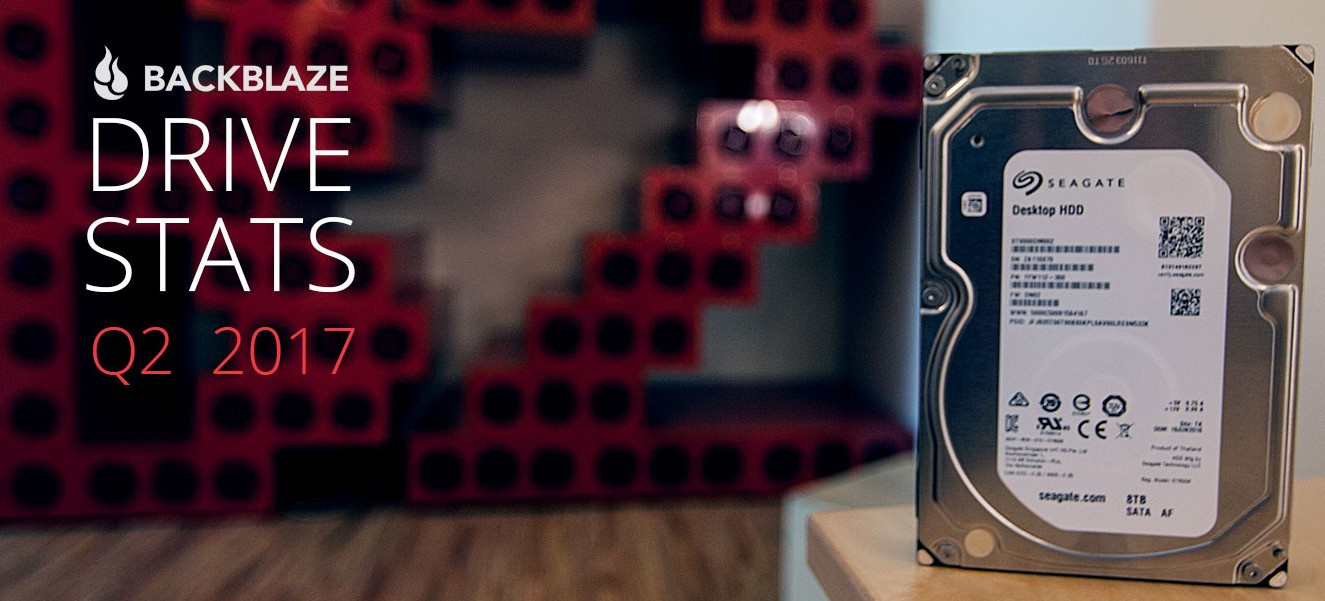
Backblaze company has published
updated statistics on the reliability of hard drives for the II quarter. 2017 The company periodically changes the HDD fleet and updates the statistics that it
first published in January 2014 .
Since the previous report for the I quarter. In 2017, Backblaze cloud storage increased by 635 disks, so their total number reached 83,151. This is not a significant addition. For comparison, in the first quarter, the base grew by more than 10,000 disks. Compared to this, the current 635 "newbies" look pale. On the other hand, now we can already sum up the first results on reliability, including those ten thousand HDDs that were added in the first quarter.
Backblaze notes that an increase in 635 HDD is a relative figure. In reality, 4921 new drives were commissioned, and 4286 old disks failed. They did not break, just Backblaze systematically migrates low-density disks to high-density disks. In addition, the number of Enterprise HDD models increased by 3,595 pieces and reached 6054 disks.
So, to the statistics of reliability.
HDD failure statistics in this table cover the period from April 1 to June 30, 2017. It contains 17 different models of 3.5 "HDD format from 3 to 8 terabytes, which worked in the company's data center during the specified period.
 Excel spreadsheet
Excel spreadsheetWhen assessing reliability, experts recommend looking at those models that have at least 50,000 indicated in the “Drive Days” column. That is, this is the minimum number of approximately 550 disks that have worked for a whole quarter. In this case, the sample is large enough to make certain conclusions. Even you risk making premature conclusions about the extremely low reliability of the four-byte Seagate ST4000DM001 and Seagate ST4000DX000 models, whose failure rates were 30.43% and 31.58%, respectively. In reality, it is early to draw such conclusions, because Backblaze has very few such disks: 400 and 157, respectively. In addition, the Seagate ST4000DM001 for the first time hit the table. These are fresh disks, and after all in the first months of work the maximum failure of disks is always observed. The rest will then continue to work - and can work for years or decades. A failure in the first months is not terrible, because it is always covered by a guarantee.
On the other hand, it is possible to draw the same premature conclusions about the exceptionally high reliability of the HGST HUH728080ALE600, Toshiba DT01ACA300, Toshiba MD04ABA400V, Toshiba MD04ABA500V, WDC WD40EFRX and WDC WD60EFRX models, which have never been out of order for a quarter. Again, this is due to too few such disks: for example, only 443 WDC WD60EFRX disks are installed. Although impressive, of course, that all 443 disks worked flawlessly from April to June.
In this report, Backblaze included a month by month indicator for the first time (the last column). It shows how the failure statistics has changed from the previous month. A green down arrow indicates an improvement.
The following table shows cumulative statistics for the period from April 2013 to June 30, 2017.
 Excel spreadsheet
Excel spreadsheetThe small sample explains the interesting phenomenon that
Enterprise drives fail more often than consumer models (compare the indicators of the “corporate” model ST8000NM005 and the consumer model ST8000DM002). By definition, this can not be, because corporate drives are much more expensive and should be more reliable.
If we take the total sample, the enterprise models have worked out 363,282 days and showed an annual failure rate of 1.61%. At the same time, consumer disks for 8 TB have worked 422,263 days (statistics from the report for the 3rd quarter of 2016) and showed an annual failure rate of 1.60%. That is, with a comparable large number of diskdays, the failure is approximately the same. Backblaze says it's too early to sum up, you need to watch further.
In general, on all models, apparently, the situation has not changed much since January 2014, when Backblaze
made the following conclusion :
- Hitachi - if it were not for the price, their entire fleet of drives would consist exclusively of these disks.
- WD - terabyte drives purchased at the very beginning still serve faithfully. Of the newer three-byte models, Western Digital Red 3TB (WD30EFRX) disks have proven themselves well.
- Seagate - their main advantage is low price. At first, they show themselves well, but over time they bring more and more problems. The company continues to purchase these discs, as in general, their purchase justifies itself.
Although there are nuances, of course. New models are constantly coming out, and reliability indicators depend on the specific model and even on the specific HDD lot. Yes, and instead of reliability, the reliability / price ratio is more important.
Starting next week, Backblaze is about to start purchasing HDDs for 12 TB.